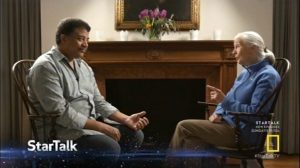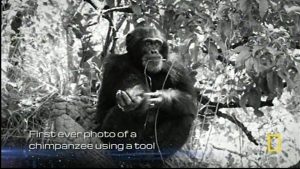A week ago, 12 Mar 2018, the National Geographic Channel broadcast a documentary that it had produced about the life and work of the World renowned naturalist Jane Goodall. Directed by Brett Morgen the film consists of an interview of Jane Goodall as a voice over for footage of her throughout the career. Much of the film used was derived from more than 100 hours of previously unreleased footage taken by Hugo van Lawick, Jane’s longtime collaborator and husband. The image below shows Goodall and van Lawick together with their son Hugo, nicknamed Grub.
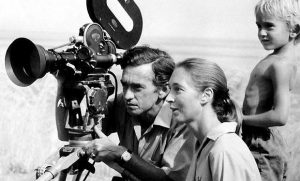
Now everybody knows that Jane Goodall has revolutionized our views of mankind’s closest relations in the natural world the chimpanzees by her intimate and long term observations of a group of chimps who resided in Gombe national forest in Tanzania. What few people know however is that Jane was initially sent to Gombe by the noted paleoanthropologist Louis Leakey as a part of his study of early human evolution. You see Leakey believed that the closest we could come to being able to study the behavior of our ancestors of two or three million years ago would be to study our closest surviving relatives the chimpanzees. The image below shows Louis and Mary Leakey with their most famous find the skull of the early hominid Zinjanthropus.
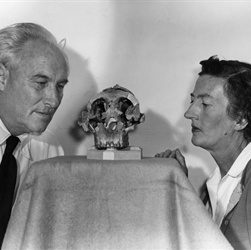
Leakey distrusted the prevailing theories about human evolution, indeed even in the 1960s there were still anthropologists who believed that humans had originated not in Africa but in central Asia despite there being absolutely no evidence to support this hypothesis. So for the job of observing chimpanzees Leakey choose his young English secretary, a woman with no university degree but who did love animals. He choose Jane Goodall.
The best part of the documentary was in fact Jane talking about her first months in Gombe. Leakey had been able to secure only enough money for Goodall to spend six months studying the chimpanzees there and any more money, and time for further study would depend on what, if anything she could discover about chimp behavior.
Upon arriving in Gombe Jane was immediately in her element. She genuinely did love animals and the outdoors and she was very happy spending her days walking around and observing the Tanzanian forests. Trouble was that she may have loved being with the chimps but they certainly didn’t return that love, not at first.
For the first five months Jane could only study her subjects from afar, the chimps ran off any time she tried to get close. By binoculars and telescope she was learning some interesting details of chimp behavior but nothing Earth shattering. Jane was quite concerned that her money would run out before she could get a real close-up look in the private lives of chimpanzees. (How many scientific discoveries do you think have been lost because of a lack of money???)
Then one day an older male chimp whom Jane had named David Graybeard did not flee as she came closer. In a breakthrough that lasted several hours she watched David Graybeard from a distance of only a few meters. Within days the entire troop had ceased to be afraid of her and Jane was able observe her subjects as close up as she desired.
It was also the male David Graybeard who gave Jane her first major discovery. One day she watched in astonishment as the chimp took a thin reed and, licking it first, he shoved it down a hole into a termite mound and when he pulled it out he gobbled up the termites that clung to it. The image below shows a chimpanzee using a reed as a tool.
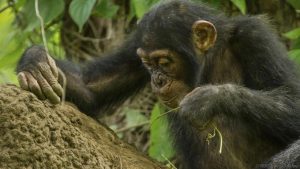
At that time no one thought chimps used tools but there he was, using that reed as a tool to obtain some necessary protein for his diet. A few days later Jane watched as several of the chimps not only used reeds and twigs to pull out some termites but were actually altering their twigs, stripping off the leaves in order to make them thinner and pointier. They were modifying if not making tools. This was the discovery Jane needed and when she announced her find the National Geographic Society, which had supported Leakey for many years, gave her all the money she required to continue her work.
There was one catch, the Geographic wanted a professional nature photographer to come and document her work. The man they sent was Hugo van Lawick who would become Goodall’s husband as well as chronicler.
In the years that followed Jane made other important discoveries. She watched as the male chimps hunted small monkeys for food, they actually succeed a higher percentage of the time than lions do. She also observed our relatives as they committed murder, even fights between groups that can only be described as wars.
In all Jane Goodall discovered that chimpanzees are very much like us. They can be tender and nurturing, Jane says she learned a lot about being a mother from a female chimp named Flo. Yet at the same time they can be viscous and brutal. All in all their behavior is not very different from our own.
No one can doubt that Louis Leakey made a terrific choice in selecting Jane Goodall to carry out a study of our relatives the chimpanzees. And you’ll be making a terrific choice if you take some time to watch The National Geographic Channel’s documentary ‘Jane’!

